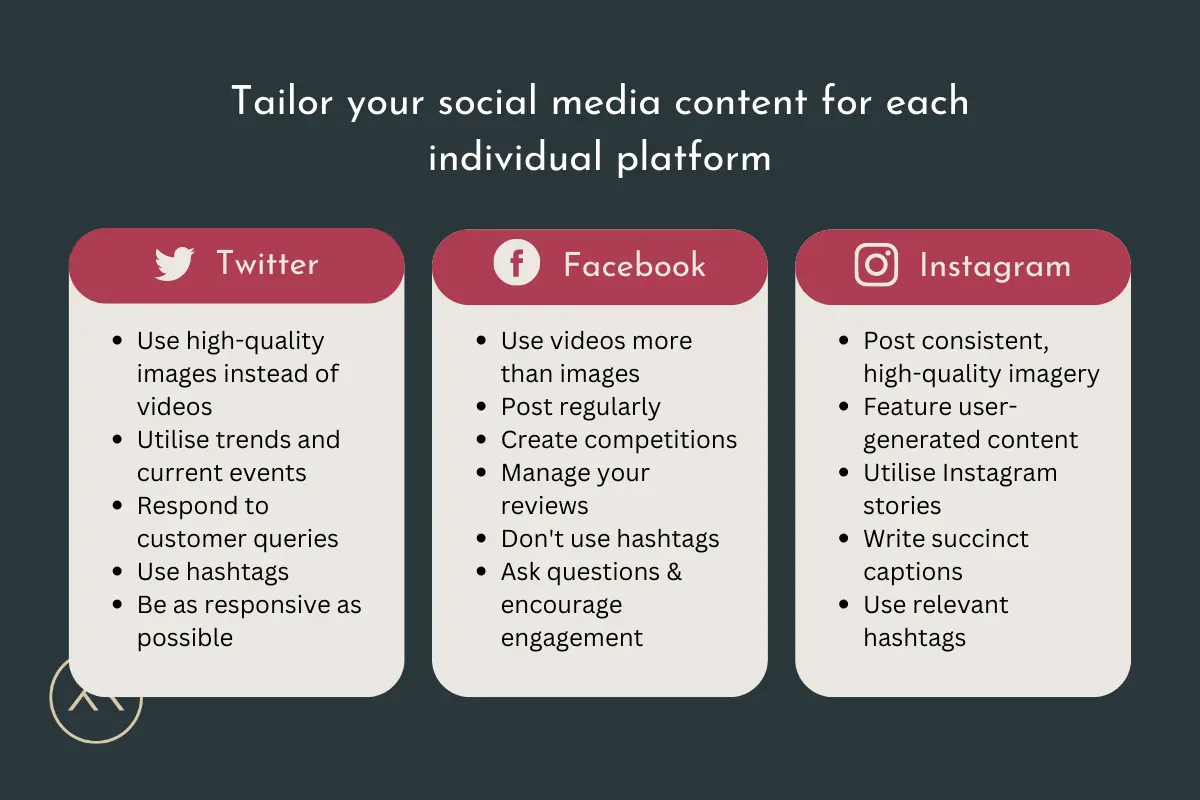
Many individuals using social media platforms for business fall into the trap of linking up all their feeds so anything they post on one of their channels will filter through to the rest of them.
Though this may seem like good practice as it saves time, this is quite a bad habit to pick up as every social channel has a slightly varied purpose, so each platform will need a different approach. Here are a few pointers to help you understand the importance of tailoring your advertising strategy for each social media platform.

Though video is said to be one of the most popular forms of content you can use to attract your audience on social media, statistics indicate that users on Twitter tweet images 361% more than they tweet videos. We would always recommend using a high-quality visual on any social media post, however with the above statistic in mind, you can see exactly how important it is to do so on Twitter especially. This is a bonus for your brand, as it’s much quicker and cheaper to produce good-quality images than it is video. If you’re needing to invest in video content for your other channels, you can rest easy in the knowledge you don’t need to spend more time reformatting it for Twitter.
Many Twitter users state that they use this platform to view news updates and stay on top of live coverage of popular global events and activities. With this in mind, you should be attempting to piggyback ‘trending topics’ if it’s relevant for your brand to do so. For example, if you’re a brand that works with food and the Great British Bake Off is currently on, try to draft tweets relating to the activity taking place within the programme. Twitter is a fast-paced channel so you need to act fast to ensure your content remains relevant. Don’t miss the opportunity by tweeting about something days after it's taken place and nobody is taking an interest in that topic anymore.
Due to the fact Twitter is a quick and easy way for users to connect with businesses online, many brands are now using Twitter as one of the main platforms to respond to customer queries and complaints. You may find that much of the engagement you receive on this channel will be comments from customers that expect a fast response. It’s important on Twitter above all other channels to keep up with its fast-paced nature and respond to any complaints and queries asap.
Hashtags are an important aspect of Twitter. They allow users to find posts about specific topics and allow brands to be seen if they use hashtags that are trending at the time of posting or are constantly popular in their target audience’s search terms. For your Twitter strategy, you should, therefore, put some time into researching popular hashtags for your industry and use them as much as possible in your content (though don’t overuse them and cram them into your content when it doesn’t feel natural to do so).
So, as the above suggests, the most important part of any Twitter strategy is to be as responsive as possible. Nothing is stopping you from scheduling content if you have business posts that will be relevant to go out at any time, but be prepared to keep an eye on Twitter activity and post as much responsive content as possible so your audience view you as a relevant account to follow on this platform.
The most visual platform of the three we’re focusing on is Instagram. Whereas it might be fine to post a variety of imagery on your Facebook and Twitter (as long as there is some kind of consistency), we would recommend posting similar imagery and graphics and using the same filters on every post on Instagram to ensure they become instantly recognisable and easy to connect with your brand. Always ensure the images/graphics you’re using are top quality or else you’ll run the risk of losing the attention of users who are only using the app to view good-quality visuals.
The best-performing Instagram images tend to feature things such as location shots, food, animals, fashion, and user-generated content. If you run a business in which you don’t often have the opportunity to take photos of those mentioned, or if your business offers services that aren’t in any way visual, it’s probably best to steer clear of Instagram altogether as your brand won’t be all that relevant to this platform. If you run a business in the leisure and tourism industry or you’re a fashion brand, Instagram could be the most useful social channel for you if utilised properly, as images of your products/images of the experience you offer can trigger FOMO from your followers, who may then become customers. Often, users of this platform aren’t here for the text, they just want to see beautiful photos. With this in mind, keep your captions relatively minimal and if you have a specific event you would like to feed your audience information about, use the Instagram stories feature instead…
So, this brings us to utilising the Instagram stories feature. Often we find that when an activity needs promoting that requires a fair amount of text to get the important information across, this is when the stories feature can step in and be your saving grace on a platform dominated by imagery. You can create as many ‘slides’ as you wish to feed the desired information to your audience, and those interested will continue clicking through to find out more. The stories feature also works particularly well to document events and live activity, as you can keep adding photos and videos as the activity progresses and avoid cluttering your feed and spamming your audience by posting too many images from the same night, which may be fine to do on Twitter where you can set up a thread for such instances, but not on your regular Instagram feed where your images won’t have the ability to appear chronologically.
As mentioned, user-generated content is particularly important on this channel. The majority of online ‘influencers’ use this channel above others to advertise brands by posting images of themselves featuring products or trying out a specific service from a brand that has either paid them to do so or offered them freebies. Connecting with influencers should be a part of your Instagram strategy, as it’s always useful to have accounts with a vast following promoting your products or services. Hashtags again can come into play at this point, as you can research what hashtags are attracting influencers and the following they have built to start building relationships with them.
Hashtags are arguably more important in general on Instagram than on Twitter as it’s easier to add more hashtags to your images by including them in a comment underneath your post, separate from the caption so as not to clutter it. This means you can spend more time researching industry-specific hashtags and include many more than you may be able to on Twitter to expand your reach further. Still, limit this somewhat so you don’t come across as spammy, we find around 10 hashtags to be an appropriate amount to use in your Instagram content.
Despite people suggesting otherwise, Facebook is probably still the most important place for your brand to existing online as 5 new profiles are created every second as of January 2019. You need to tap into that vast audience with quality content guaranteed to capture their attention. Whereas images perform better on Twitter than video, video content drives higher engagement and interactions from Facebook users compared to any other type of content on the platform. You don’t need to spend a fortune on video, and they don’t need to be lengthy clips. Apps such as Boomerang now exist which will allow you to take short, fun videos of things relating to your products and services.
Facebook users have stated that they use this platform mainly to have discussions with their friends and family, see updates from people they know, and to share memes. This is why Facebook has recently made updates to their algorithm to ensure users are seeing more posts from their online friends than they are from business accounts. Despite this, users will still look for brands they’re contemplating purchasing from on Facebook to verify their authenticity. So, despite the algorithm updates, it’s still important for you to be posting regularly to reassure your Facebook followers of your reliability. You just need to ensure you’re sharing content that may encourage users to tag friends and family and start a discussion. This is why competitions do so well on Facebook as people often tag other users in the post to win, which means the post will then appear on the feeds of their Facebook friends, encouraging others to tag and thus growing the reach further.
When people are looking to brands to prove their authenticity on Facebook, they will often look at the reviews posted on the page to see what others who have already used the products/services thought. Instagram and Twitter profiles don’t have a review section displayed, so you must stay on top of the reviews being posted on your Facebook page to thank people for leaving a positive write up and to show potential customers that you’re willing to resolve the negative ones. If users can see negative reviews that have been left unanswered, they’ll be less likely to trust your brand and therefore less likely to become one of your customers. Try and resolve negative reviews within a day to demonstrate your willingness to better your brand and provide good customer service.
As opposed to Instagram and Twitter in which hashtags are incredibly useful, statistics show that the use of hashtags on Facebook is likely to decrease engagement on posts. This is where it proves to be important that you aren’t linking up all your channels to post the same content across all of them. It could be incredibly damaging to your Facebook page if Instagram or Twitter posts are being filtered to include any hashtags you’ve used.

The above information showcasing the individual needs of each social media platform should hopefully demonstrate the importance of varying your content so it’s specifically tailored to each channel. Your overall brand image and message should remain the same, so the channels need to complement each other, but hopefully, you can now see why a different approach is needed for each one. There are other social media platforms that you may want to work into your overall strategy, and they too will need a separate approach to the ones discussed. Keep in mind that features designed for individual platforms may work perfectly on the appropriate channel, but won’t necessarily work on the others, hence why linking up your feeds is a big no-no.
Once you've gained a good understanding of how to approach each social media platform, read up on how to ensure you're targeting the right online audience.
You'll receive an email update every 2 weeks with insight and advice to support you in your digital marketing journey. We treat your email address with care, and you can unsubscribe with just a click.